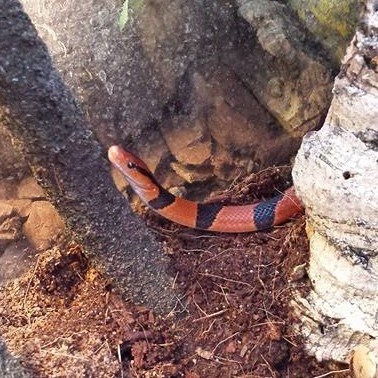Copyright 2021 Evolution Reptiles
All rights reserved.
Copyright 2025 Evolution Reptiles
All rights reserved.
All rights reserved.
Originally from Central China, the provinces of Yunnan, Sichuan and Shaanxi, their other common name is bamboo rat snake. They can be found in mountain forests at altitudes of between 1000 – 2600m above sea level. They like to hide under leaf litter, moss carpets and rocks and logs. They prefer the cool humid conditions that this provides.

Stunningly beautiful, they have a background colour of bright red that fades to a bright shade of orangey red as they mature, a pale ventral surface, and black bands as a hatchling that fade slightly with age. These striking markings make them a very desirable snake that, until recently, was only available as wild caught individuals that tended not to survive long. Once it was realised that they prefer cool, damp conditions and a substrate they can burrow in, survival rates improved, and you are much more likely to see healthy captive bred youngsters available these days.
We recommend glass terrariums for this particular species, allowing you to keep them at the correct temperature more easily. These guys like it cool and slightly damp! They are also designed with snakes in mind so escapees are unlikely (Remember to shut the doors properly!). A wooden vivarium does offer more privacy for the snake, but as long as plenty of hides are provided the snake should feel secure.
Yunnan rat snakes require a temperature gradient of 23°C to 27°C (73°F to 80°F) during the day. This can be achieved by using a deep heat projector mounted on one side or on top of the vivarium to create a warmer end of the vivarium. This must be controlled by a thermostat, as these snakes can be very sensitive to high temperatures.
It is very important to know what the temperature is, so check regularly with an accurate digital thermometer.
Although it has always been assumed that snakes do not need UV lighting, it is always a good idea to provide it. Low output T5 UV tubes are now available that can mimic the levels of UV that they would be exposed to in the wild, and we have found that when it is provided they will definitely use it.
There are many different types of substrate available, but as this snake is a forest floor dweller that likes to burrow the best are probably coir fibre, orchid bark or a mix of the two. Make sure your snake cannot accidentally ingest substrates when feeding. Bioactive or naturalistic substrates work extremely well for this species, and there are plenty of choices available when it comes to plants tough enough to withstand a digging snake.
The snake will require quite a few hides in the vivarium so that it can feel secure. By having multiple hides in different areas, the snake will be able to choose the one at the best temperature. A humid hide is also recommended. These are hollow hides with damp moss inside; snakes will often use these when they are shedding their skin.
Feed your snake one defrosted mouse every 1-2 weeks. The mouse should be no bigger than the largest part of the snake. Yunnan rat snakes can eat mice their entire lives – starting off with pinkies as a hatchling and moving up in size as the animal grows. As these snakes have a narrow head, they often prefer several smaller prey items at a time as adults rather than a large mouse.
Although these are an unusual species of snake and are often seen as quite delicate, they can be remarkably robust if given the correct conditions.
Common name: Yunnan Rat Snake
Scientific Name: Oreocryptophis porphyraceus pulchra
Location: Central China
Habitat (wild): Mountain forests at altitudes of between 1000 – 2600 m above sea level.
Captive environment: Terrestrial glass or wooden vivarium of at least 90cm
Preferred temperature range: 23ºC to 27ºC (73 to 80ºF), with a temperature drop at night. Temperatures over 29ºC (84ºF) will not only cause distress, but can kill.
Ferguson Zone: Zone 1
UVB Lighting: 5% or 7% UVB strip lamp
Lifespan: 15 to 20 years, but can be more
Copyright 2021 Evolution Reptiles
All rights reserved.